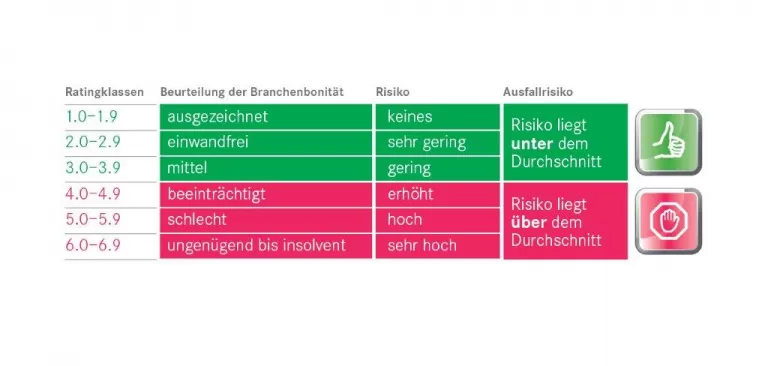Tool for assessing the credit standing of Austrian business sectors
Sound basis – up-to-date results
The KSV1870 BalanceSheetSectorRating is a high-performance tool that can be used to assess the credit standing of various sectors in Austria. Giving due consideration to all key spheres of influence, it describes a sector’s situation using one single indicator and provides information about the future probability of default.
The KSV1870 BalanceSheetSectorRating objectively determines the credit standing of individual sectors.

An accurate indicator for probability of default
The KSV1870 BalanceSheetSectorRating indicates how likely it is
for a sector to experience payment difficulties in the year ahead. The 6-tier scale with 10 sub-classes each...
- yields a total of 60 rating classes.
- provides information on the situation of a particular sector.
- shows up developments to be expected.
- is validated once a year.
- is updated on the basis of new annual financial statements and insolvency information.
- includes over 146 individual reports and thus covers a wide bandwidth of different branches.
Assessing the credit standing of a sector
Excellent
When the insolvency rate is low, the sector is doing well. When the asset pool is sufficient, even extended periods of crisis can be navigated successfully. The forecast for the sector is better than average.
Sound
Good solvency can be expected in the short and medium term. Sufficient capital endowment warrants good credit standing for the long run, too. Only a serious deterioration of the sectoral environment would give rise to difficulties.
Average
No developments are expected next year that would put the credit standing at risk. Unfavourable developments may occur in the medium term; probability of default is below average.
Impaired
The credit standing will remain stable in the short term. However, the sector's reserves are low. Its financial situation is between average and somewhat impaired.
Poor
The sector has a high risk of insolvency. All it needs is short-term unfavourable developments to lead to additional company defaults. The insolvency rate will increase.
Unsatisfactory to insolvent
The credit standing of the sector’s companies suggests very high insolvency risk and insolvencies. Further structural adjustments are expected in this sector.
Data quality, cooperation and background.

Every year, the balance sheet database of the Austrian Institute for SME Research provides some 100,000 anonymised annual financial statements of solvent and insolvent companies. The key figures in the model cover all central areas, including financing, investments, assets, productivity, income, turnover rate, liquidity and expenses. In addition to these conclusive balance sheet and income statements figures, the database also includes anonymised insolvency data.
The high-performance database of KSV1870 gives a particularly precise and highly up-to-date pictures of insolvencies in Austria. Moreover, KSV1870 provides information on company size. All things considered, the rating model allows for an objective determination of credit standing at sector level. It goes without saying, that the KSV1870 BalanceSheetSectorRating meets the
quality standards for rating models as set forth in the OeNB/FMA Guidelines.




